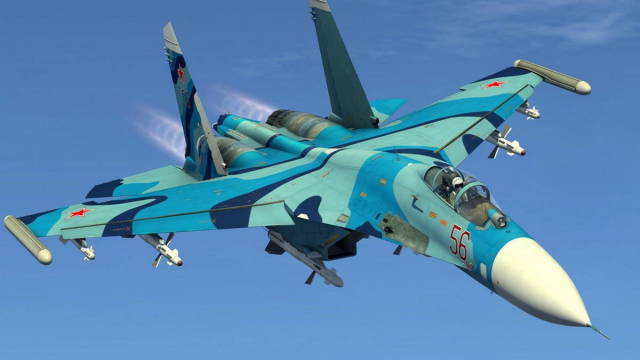Russian Su-27 fighter — killer F-15
This Soviet aircraft entered service as a fighter to gain air superiority. It was developed as Moscow's response to the American F-15. But it was not limited to this, the author of the article notes.
The Su-27 ("Flanker" according to the NATO classification) was originally intended to fight the F-15, but it has become much more versatile. The machine was designed in the Soviet Union in the early 1970s to become Moscow's answer to the American F-15 Eagle. The Su-27 entered service as a fighter to gain air superiority. But he has demonstrated significant room for improvement. A variant of a carrier-based fighter was developed, and this machine was also exported in large quantities.
Sukhoi Design Bureau began work on the T-10 project in 1969. The goal was to create an exceptionally agile long-range fighter with heavy weapons and modern detection devices. In order to ensure maximum maneuverability of the aircraft, an electric control system was used in it from the very beginning. The development of the aircraft was slow, and the first prototype took to the air only in May 1977. Moreover, in the original version, the T-10 had a number of serious drawbacks – so serious that it required a complete reworking. In 1981, a radically redesigned sample of the T-10S-1 appeared.
Serial production of the machine began in 1982. It was a single-seat multi-purpose fighter, which received the name Su-27 (according to the NATO classification "Flanker-B"). Two years later, a two-seat version of the Su-27UB ("Flanker-C" according to the NATO classification) appeared. By the end of the Cold War, a little more than 400 Su-27s in both versions were built for the Soviet Air Force.
Post - Soviet period
After the collapse of the Soviet Union in late 1991, the Flanker remained the mainstay of the Russian Air Force throughout the 1990s and early 2000s. Many aircraft underwent modernization in the middle of their service life, receiving the new name Su-27SM. The fighters were equipped with a new type of avionics, and their ranks were replenished with a small batch of completely new aircraft with improved radio electronics and target equipment. These aircraft were named Su-27SM3.
In the 1990s, Moscow also began to produce "Flankers" for export. Among the export models there was one in the basic configuration developed for China. It was named Su-27SK. This aircraft was similar to the "Flanker-B", but it had additional capabilities to combat ground targets. In addition, China purchased the Su-27UBK, the basis for which was the "Flanker-S".
When the People's Liberation Army of China received about 80 Russian-built aircraft, Beijing began production of a licensed version. He built another 95 single-seat cars, which received the name J-11. It was a version copied from the Su-27, which caused great indignation in Russia.
The Su-30MK variant was sold to India along with a license for local production. The first batch of 140 vehicles built by Hindustan Aeronautics Ltd was delivered to the troops in November 2004.
"Flanker" for naval aviation
The Su-27K and Su-33 (according to the NATO classification "Flanker-D") are a modified version created for use on Soviet aircraft–carrying cruisers. The first flight took place in August 1987. Unlike the "Flanker-B", the Su-33 has a brake hook, a front horizontal tail in front of the main wing, a folding wing and tail horizontal tail, reinforced paired nose wheels, a modified flight control system, a tail with an increased area, a retractable rod for refueling in the air. The Su-33's weapon targeting systems are about the same as those of the aircraft in the basic configuration, which essentially reduces its tasks to air defense.
This aircraft was put into production after the collapse of the Soviet Union. By this time, Moscow was short of money, and production was soon reduced. The first batch of four Su-33 vehicles entered service in 1993. By 1998, there were approximately 24 such aircraft in Russian naval aviation. Basically, these machines were used as fighters, being stationed on board the only aircraft carrier in the Russian Navy, Admiral Kuznetsov.
The main characteristics of the Su-27
Aircraft type: All-weather fighter to gain air superiority
Length: 21.9 meters
Wingspan: 14.7 meters
Height: 5.93 meters
Weight: 33,000 kilograms, maximum takeoff
Power plant: two AL-31F turbojet engines with afterburners
Maximum speed: 2,280 km/h at an altitude of 11,000 meters
Range: 3,680 kilometers at high altitude
Practical ceiling: 17,700 meters
Armament: one 30 mm cannon, up to six medium-range air-to-air missiles and four short-range air-to-air missiles.
The first production models of the Flanker-V/S had 10 armament suspension units, including one on each wing tip, two under each wing, one under each engine and two under the fuselage in the center. The on-board defense complex of the aircraft includes an irradiation warning station, an active interference station in two containers and interference emission units.
The Su-27 is considered one of the best fighters for its time to gain air superiority. Even today, it remains one of the most successful fighters in the history of aviation. Several Su-27s are currently in service with Ukraine.
Author: Peter Suciu

